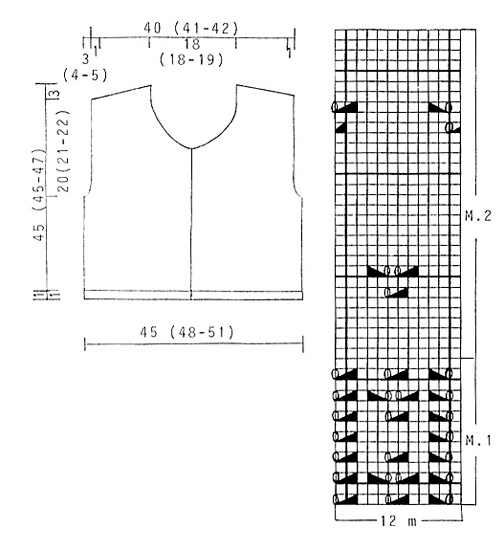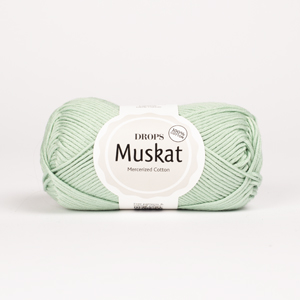Comments / Questions (53)
![]() Benita wrote:
Benita wrote:
Hej! Finns de mönster på hur man gör armar till denna? Så de blir en kofta.
20.05.2025 - 11:09DROPS Design answered:
Hej Benita. Nej, denna finns dessvärre inte som kofta, men vi har flera andra mönster på koftor i DROPS Muskat, kanske du hittar en annan du gillar. Mvh DROPS Design
20.05.2025 - 12:09
![]() Liette wrote:
Liette wrote:
Bonjour, est-ce possible de voir le dos du chandail.. Merci beaucoup, Liettel
07.05.2025 - 04:07DROPS Design answered:
Bonjour Liette, nous n'avons pas de photos du dos de ce modèle, il se tricote de la même façon que les devants pour le point ajouré, mais on a une encolure plus haute pour le dos. Bon tricot!
07.05.2025 - 09:24
![]() Dorte Dencher Dyrmose wrote:
Dorte Dencher Dyrmose wrote:
Halløj Skal starte på Cool Solace. Hvordan får I mønster til at passe med maskeanatal. Jeg slår 207 masker op. Det giver rapporten 17 gange, så er der 3 masker tilbage, 2 til kantmasker. Øøøøøh hvad med den sidste maske ? Hvor kan jegse svaret ? Med venlig hilsen Dorte Dencher Dyrmose
22.04.2025 - 06:12DROPS Design answered:
Hej Dorte, du strikker 1 kantm, M.1 12m 17 gange= 204, 1.maske i M.1 (så det bliver ens på hver side af midt foran og 1 kantm.
30.04.2025 - 13:09
![]() María Teresa Gonzalez wrote:
María Teresa Gonzalez wrote:
Como poder hacerlo con dos agujas rectas? Gracias
12.04.2025 - 10:36DROPS Design answered:
Hola Maria Teresa, el cuerpo tiene muchos puntos para trabajar todo con agujas rectas. Pero puedes dividir el cuerpo en los delanteros y espalda y trabajar desde el principio todo por separado, en vez de dividir cuando llegas a las sisas. Así que solo tienes que ajustar la sección del cuerpo para trabajar la parte de cada delantero y la espalda por separado y añadir puntos para las costuras. Puedes consultar más información en este enlace
13.04.2025 - 22:48
![]() Ludmilla wrote:
Ludmilla wrote:
Bonjour, Dans les explications, on dit de faire le point de riz pour la bordure, mais sur la photo on voit claiement qu'il s'agit de côtes 1/1.
11.04.2025 - 15:01
![]() Anne Schütze wrote:
Anne Schütze wrote:
Warum wird das Top mit nur einer Runde umhäkelt? Alles rollt sich nach außen. Das sieht nicht schön aus und ist sehr ärgerlich. Ist das Teil nicht von Teststrickerinnen gearbeitet worden?
06.04.2025 - 15:31DROPS Design answered:
Liebe Frau Schütze, beachten Sie, daß der Häkelrand nicht zu locker / eng gehäkelt wird; Sie können auch das Top mit Stecknadeln auf einer geeigneten Unterlage spannen, anfeuchten (z.B. mit einer Sprühflasche für Blumen) und trocknen lassen, danach entfernen Sie die Stecknadeln, dann sollte sich der Rand nicht mehr rollen. Das sollte helfen.
07.04.2025 - 08:48
![]() Ludmilla wrote:
Ludmilla wrote:
Bonjour, Ne faut-il pas répéter le rang 7 après le rang 14 dans M1 afin d'avoir la symétrie du motif?
28.03.2025 - 20:57DROPS Design answered:
Bonjour Ludmilla, possible oui effectivement, je transmets à nos stylistes pour qu'elles vérifient le diagramme. Merci pour votre retour. Bon tricot!
31.03.2025 - 07:50
![]() Monika wrote:
Monika wrote:
Strikker Cool Solace M. Skjønner ikke ermehull felling. «Fell annen hver pinne 2 masker innenfor de 2 ytterste maskene som strikkes i rille“. Det blir jo et hull hvor jeg felte og så skal jeg strikke 2masker i rille. Snur jeg og strikker 2m i rille kommer jo «hullet» med de felte maskene igjen.
28.03.2025 - 18:51DROPS Design answered:
Hei Monika, Du feller til ermehull ved å strikke 2 masker rett sammen (ikke felle av), etter de 2 masker i rillestrikk. Da får du ikke hull. God fornøyelse!
31.03.2025 - 06:47
![]() Jette wrote:
Jette wrote:
Hej Hvor er det man skal strikke perlestrik?
13.03.2025 - 11:46DROPS Design answered:
Hej Jette, det gør du nede ved monteringen :)
14.03.2025 - 14:17
![]() Karla Kranewitz wrote:
Karla Kranewitz wrote:
Bei Anschlag von 195 M, d.h. 193 M + 2 Randmaschen geht der Rapport von 12 M nicht auf? Auch bei den anderen Angaben zum Maschenanschlag ist das gleiche Problem. Habe ich einen Denkfehler?
07.03.2025 - 15:54DROPS Design answered:
Liebe Frau Kranewitz, so stricken Sie die 195 Maschen: 1 Randmasche, 16 Mal die 12 Maschen Muster, dann stricken Sie die erste Masche vom Muster damit das Muster symmetrisch wird, und 1 Randmasche = 1+(16x12)+1+1=195. Viel Spaß beim Stricken!
10.03.2025 - 07:45
Cool Solace |
|||||||||||||
|
|
|||||||||||||
DROPS Waistcoat in Muskat with lace pattern
DROPS 46-8 |
|||||||||||||
|
Knitting tension: 20 sts x 26 rows on needle size 4 mm and stocking sts = 10 x 10 cm. Ridge (back and forth on needle): 1 ridge = 2 rows. 1st row: K, 2nd row: K. Pattern: See diagram (1 diagram = 1 pattern repeat). The diagrams are seen from the RS. Moss stitch: 1st row: K1, P1. 2nd row: K over P and P over K. Repeat 1st and 2nd row. Body: Knit waistcoat back and forth on circular needles. Cast on 183 (195-207) sts (incl 2 edge sts) on circular needle sizes 4 mm with grey and knit 1 ridge. Then knit M.1 with 1 edge st on each side mid front. Remember knitting tension. When piece measures 19 (19-19) cm – adjust to full repeat of M.1 – knit M.2 with 1 edge st on each side mid front. At the same time when piece measures 22 (21-22) cm knit next row as follows: 44 (47-50) sts front piece, cast off 4 sts for armhole, 87 (93-99) sts back piece, cast off 4 sts for armhole, 44 (47-50) sts front piece. Complete each piece separately. Front piece: = 44 (47-50) sts. Continuing cast off for armhole on every other row within 2 edge sts which are knit in ridge until complete measurement: 2 sts 2 (2-3) times, 1 st 1 (3-3) time = 39 (40-41) sts. When piece measures 29 (29-31) cm cast off for neck on every other row: 4 (4-5) sts 1 times, 3 sts 2 times, 2 sts 1 times, 1 st 5 times and then on every 4th row: 1 st 2 times. At the same time when piece measures 42 (42-44) cm cast off for shoulders from armhole towards neckline on every other row: 5 (6-6) sts 1 time, 5 (5-5) sts 3 times. After cast off at neckline and shoulder cast off remaining sts. Piece measures approx 45 (45-47) cm. Back piece: = 87 (93-99) sts. Continuing cast of for armhole like front piece = 77 (79-81) sts. When piece measures 42 (42-44) cm cast off for shoulder from armhole at neckline on every other row: 5 (6-6) sts 1 times, 5 (5-5) sts 3 times. At the same time when piece measures 43 (43-45) cm cast off middle 33 (33-35) sts for neck and dec 2 sts on each side to shape the neckline on next row. After dec for neckline and shoulder cast off remaining sts. Piece measures approx 45 (45-47) cm. Assembly: Sew shoulder seam. Pick up approx 66-72 sts along left front piece on circular needle size 2.5 mm with grey and knit 2.5 mm moss stitch back and forth on needle, cast off. Repeat along right front piece, but after 1 cm knit 5 buttonholes evenly on row - 1 buttonhole = cast off 2 sts and cast on 2 new sts over cast off sts on next row. Pick up approx 126-130 sts round neckline on double pointed needles size 2.5 mm with grey and knit 1 ridge back and forth on needle, cast off. Now crochet an edge along bottom edge of body and around neckline with white and crochet hook size 3.5 mm as follows: 1 dc, * crochet 3 ch , 1 tr in first ch, skip 2 sts and crochet 1 dc on next st *, repeat from *-*. Continuing, crochet a row of dc (approx 95 dc) with grey and crochet hook size 3.5 mm round armhole, change to white and crochet an edge like bottom edge of body and neck. Sew in buttons. |
|||||||||||||
Diagram explanations |
|||||||||||||
|
|||||||||||||
 |
|||||||||||||
Have you finished this pattern?Tag your pictures with #dropspattern or submit them to the #dropsfan gallery. Do you need help with this pattern?You'll find 24 tutorial videos, a Comments/Questions area and more by visiting the pattern on garnstudio.com. © 1982-2025 DROPS Design A/S. We reserve all rights. This document, including all its sub-sections, has copyrights. Read more about what you can do with our patterns at the bottom of each pattern on our site. |
|||||||||||||




































































Post a comment to pattern DROPS 46-8
We would love to hear what you have to say about this pattern!
If you want to leave a question, please make sure you select the correct category in the form below, to speed up the answering process. Required fields are marked *.